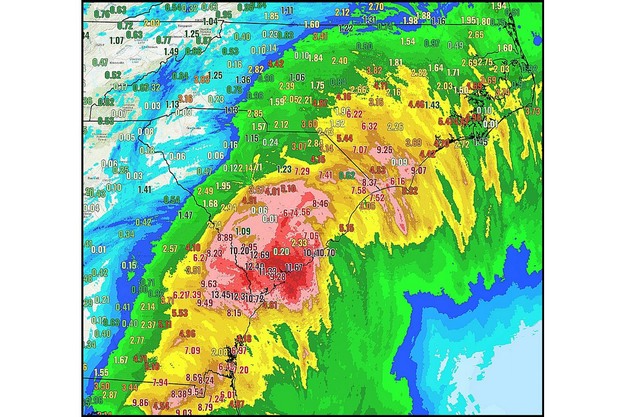This past Monday, Hurricane Debby made landfall in Florida as a category 1 hurricane before weakening to a tropical storm. From Florida, the storm slowly moved up the East Coast and hit Georgia and South Carolina.
Florida citrus
Rainfall in Florida varied from 6 to 27 inches and the crops most threatened by the amount of rainfall are watermelons and cantaloupes that are in season now. In addition, strawberry plants may have been impacted by the amount of water. The state's citrus production region has been spared from the flooding rains. "The bulk of citrus is grown in Central Florida, which wasn't seriously impacted by the wind or flooding. However, some minor fruit loss is suspected in a few of the western most production counties," says Drew Lerner with World Weather, Inc.

Tropical Storm Debby (downgraded from hurricane status) has plagued the U.S. Carolinas with excessive rain and flooding this week.
Limited damage in Georgia
In Eastern Georgia, rainfall from Debby has varied from 6 to 13+ inches. Wind speeds of 40 to 65 mph. occurred in northern Florida as well as Georgia and may have caused damage to some tree crops. While damage still needs to be assessed, most tree crops won't experience serious loss except in areas where fruit droppage was possible.
In South Carolina, the state's key vegetable growing region is in the far south where some of the greatest rainfall occurred. This time of year, peaches and nectarines are key crops in the state. In addition, the season for Asian pears is starting up in all three states.
Early assessments of the crop damage are still not available in any of these states. However, the flood water is receding in Florida and damage assessments are now starting. In Georgia, assessments will begin after the rain ends on Thursday. Over in South Carolina, heavy rain is still falling, and damage assessments won't begin until Friday.
Drowning crops
"The damage will be most serious to low-lying fruit and vegetable crops in northern Florida as well as a few counties in South Carolina," Lerner said. Some damage is expected in Eastern Georgia as well, but less extreme. Florida and parts of South Carolina are likely dealing with drowning crops, causing complete losses of production. However, until the flood water recedes, farmers will not be able to assess the damage.
For more information:
Drew Lerner
World Weather, Inc.
Tel: (913) 383-1161
worldweather@bizkc.rr.com
www.worldweather.cc
